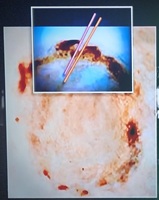Computer Vision Syndrome Eye Color Accuracy Assessment
Bitmap.us is a patented web-based stereoscopic acuity computation to diagnose computer vision syndrome.
|
* Instructions *
* 1. Take a color picture of an item, area, or scene you believe you question what color you are
seeing or what color it is. This is the unknown target color you want to highlight, identify,
and interpret.
* 2. Crop photo to an item, area, or scene to target.
* 3. Choose a known color to target that closely resembles your unknown color.
* 4. Choose Gamma, Threshold, or modify the Binocular color computation.
* 5. Upload the color picture that contains your unknown target color you want to highlight,
identify, and interpret.
* 6. Choose photo width.
* 7. Choose Eye Preference to test color variation in each eye and to see which eye is dominate.
* 8. Compute.
* 9. Pick an object from your photo that contains the target color to fixate on.
* 10. Close one eye at a time.
* 11. Result: The open eye that sees your target color that matches the chart
color is your dominant eye.
Learn more about our vision.repair algorithms.
|
|
|
|
| Choose a known color to target. |
| Choose a known color to target that closely resembles your unknown color. |
| Known Colors: |
|
| Color: |

|
|
— OR —
|
|
Use our color chart or color table to find a color.
|

|
• Binocular color computation creates a binocular computation of two colors which is
used to calculate, highlight, or identify the variation of a third color and present that
color, independently, one to each eye in stereo to diagnose blurry vision caused
from digital eye strain.
• Gamma correction is used for binocular color enhancement.
• Threshold is used for segmenting objects.
|
Binocular color computation:
Gamma:
Threshold:
• The Binocular color computation must be set to any value above .0, to add gamma or threshold.
• Binocular color computation min=.0 , max=.255 [.0 no color, .255 for best color results]).
• The larger the computation value, the stronger the gamma or threshold effect.
|
|
| For best results, use high-resolution images 1920x1080 or larger in .jpg or .png format. |
| Max file size: 5MB. Max file name length: 100. |
| Upload a photo that contains your unknown target color. |
| Crop Photo, No Effect or choose from our Bing™ Wallpaper Archive, |
|
|
| The computation will try to highlight and identify your unknown color from known colors if possible. |
| If the color found is not listed as a known color then the color found is a variation of a known color. |
Photo Width:
pixels


|
Eye Preference. |
Eye Preference / Ocular Dominance / Dominate Eye:
|
BACKGROUND OF THE INVENTION
1. Field of the Invention
(1) The present invention relates to stereoscopic visualization and more specifically to a stereoscopic method
for highlighting the variation of colors and eye color accuracy test, which utilizes a computer-implemented,
web-based computation for what colors the eye as seen through real world image data of stereoscopic
photographic subject matter rather than just for color itself.
2. Discussion of the Prior Art
(2) This computational method is made to address color accuracy from the difference of variation of a similar
color that is seen in the real world to image data from stereoscopic photographic subject matter seen by a subject
using binocular vision and their ability to tell the difference among a specific color from a similar color rather
than from some random colors seen on a piece of paper.
(3) Accordingly, there is a clearly felt need in the art for a stereoscopic method for highlighting the variation of
colors and eye color accuracy assessment/test, which utilizes a computer-implemented, web-based computation
for what colors the eye as seen through real world image data of stereoscopic photographic subject matter rather
than just for color itself by highlighting matching colors in relation to the field of ophthalmology with binocular
vision.
|
Photo notes.
|
• The photo side opposite of known color to target is original photo.
• Photos must be .jpg, or .png, not exceed 5MB, and max width by height is (w)3840px (x) (h)3840px.
• To capture the exact shade of the unknown color from your cellphone or camera. A digital photo taken must be
12 megapixels or greater and be a sharp zoom index of 1.0x or in that range for best results.
|
• Larger width numbers, the larger the photo.
• Width can be any number between 16 and 3840.
• Transparent highlights and identifies colors with no Binocular color computation.
• Colors highlights and identifies colors on the Ocular Dominance side of the photo.
• RGBY (Red-Green & Blue-Yellow) might change existing colors a the pixel level.
• Highlighting or identifying colors is based on high photo pixel bit depth and photo quality.
• Some matched colors may not be highlighted or identified based on pixel bit depth and photo quality.
|
How the computation can help your eyesight.
|
• The computation can test from picturesque data for visual acuity, color deficiency, contrast sensitivity,
Myopia (nearsightedness), Hyperopia (farsightedness), and blurry vision caused from digital eye strain.
• To make an accurate color identification the computation will highlight the variation of the unknown color first
and try to match the color from known colors to identify.
|
|
|
|
|
Example - Dental impressions of suspect in murder case - Order Printed
 
|
|
Mail To (Optional)
E-mail photo to yourself or ...
|
|
|
|
|
Uploading... Please... Wait...216.73.216.174
|
x
Your data is protected by the HIPAA Privacy Rule. |